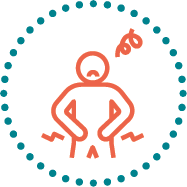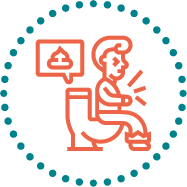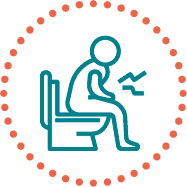All about irritable bowel syndrome (IBS)
Irritable bowel syndrome (IBS) is one of the most commonly diagnosed gastrointestinal disorders and can have a significant impact on your quality of life.1 It causes symptoms like:

Stomach cramps

Bloating

Diarrhoea

Constipation1,2
The exact cause of irritable bowel syndrome (IBS) is unknown1,2 but it is believed to be linked to food moving through the gut too quickly or too slowly, sensitive nerves in the gut, stress or a family history of IBS.2 Assessing your diet is the first step to managing your symptoms.3
The low FODMAP diet, what it is and how it works
Get to know the FODMAPs before you start
FODMAPs stand for oligosaccharides, disaccharides, monosaccharides, and polyols.1d,e FODMAPs are poorly absorbed by the small intestine drawing more water into the colon. They are rapidly broken down by the colon bacteria, causing symptoms of irritable bowel syndrome (IBS).1
Take the following steps to ease those symptoms
The low FODMAP diet consists of two phases. In the first phase you will eliminate foods that are high in FODMAPS for 6 to 8 weeks. Keep a diary to track your symptoms. If your symptoms are successfully controlled, you can start the second phase, which is less strict. In this phase you will gradually add high FODMAP foods back into your diet while maintaining adequate symptom control.1
Step 1 – Elimination
Take out high FODMAP foods
Step 2 – Reintroduction
Add certain FODMAP foods back into your diet and monitor your symptoms
Step 3 – Personalisation
Create a diet plan that provides IBS symptoms relief
List of high FODMAP foods to eat and avoid1
Oligosaccharides (fructans/galactooligosaccharides)
Vegetables
Avoid – artichokes, asparagus, beets, brussels sprouts, broccoli, cabbage, fennel, garlic, leeks, okra, onions, peas, shallots
Alternatives – bamboo shoots, bell peppers, bok choy, carrots, celery, chard, chayote, chives, choy sum, corn, eggplant, green beans, lettuce, parsnips, pumpkins, spring onions (green part only), tomatoes; onion and garlic substitutes: garlic-infused oil
Fruits
Avoid – watermelon, apple, white peaches, persimmon
Alternatives – Bananas, blueberries, cantaloupes, carambola, durian, grapefruit, grapes, honeydew melon, kiwi, lemons, limes, mandarin, oranges, passion fruit, pawpaw, raspberries, strawberries, tangelos
Wheat and rye (when eaten in large amounts)
Avoid – bread, pasta, couscous, cookies, crackers, biscuits
Alternatives – gluten-free and spelt bread and cereal products
Legumes
Avoid – chickpeas, lentils, kidney beans, baked beans, soy beans
Alternative – canned chickpeas
Disaccharides lactose
Avoid – milk (cow, goat, sheep), yogurt, soft cheeses, custard, ice cream
Alternatives – gluten-free and spelt bread and cereal products
Monosaccharides (fructose)
Fruits
Avoid – apples, Asian pears, pears, clingstone peaches, mango, sugar snap peas, watermelon, canned fruit in natural juice; large total fructose dose: concentrated fruit sources; large servings of fruit, dried fruit, fruit juice
Alternatives – as listed above under oligosaccharides
Sweeteners
Avoid – fructose, high fructose corn syrup
Alternatives – any except polyols
Other
Avoid – honey
Alternatives – Maple syrup, golden syrup
Polyols
Vegetables
Avoid – avocados, cauliflower, mushrooms, snow peas, sweet corn
Alternatives – as listed above under oligosaccharides
Fruits
Avoid – apples, apricots, Asian pears, cherries, longon, lychee, nectarines, peaches, pears, plums, prunes, watermelon
Alternatives – as listed above under oligosaccharides
Sweeteners
Avoid – isomalt, maltitol, mannitol, sorbitol, xylitol
Alternative – sucrose, glucose
It is important to note that you’ll need expert help when starting the low FODMAPs diet. A dietician can help you with setting up an eating plan and helping you discover what works for your body and what triggers your IBS symptoms.
- Remember that the low FODMAP diet isn’t for life
- Discuss your progress with your dietician or healthcare professional. After 6 to 8 weeks, they can help you with gradually reintroducing high FODMAP foods
- FODMAPs are found in everyday foods
- Take it slow and don’t put too much pressure on yourself
- Get the support of friends and family
- Plan ahead as going to a restaurant can be stressful. If possible, get the menu beforehand
- Preparing meals can become tricky but get creative and have fun with trying out new recipes
BY MANAGING YOUR IBS SYMPTOMS THROUGH THE LOW FODMAP DIET, YOU CAN IMPROVE YOUR QUALITY OF LIFE.

